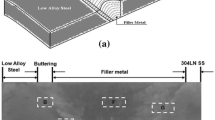Abstract
Modern computational calculation power enables scientists to accurately predict the microstructural evolution of complex metallurgical systems and, for example, their phase formation at elevated temperature for an extended amount of time. Valuable information can be derived from those calculations without the necessity of expensive and complicated experiments. Especially the field of power generation, where service parameters strongly influence the applied materials, can benefit from computational simulations. This study will highlight the use of thermodynamic simulations on the behavior of T23 to T91 ferritic dissimilar metal welds (DMWs) at elevated temperatures, similar to creep conditions. The software MatCalc is used to calculate precipitation sequences in the base metals, as well as carbon migration in DMWs from the higher alloyed to the lower alloyed material at elevated temperatures and precipitate distribution across the fusion line of the DMWs. The results of the simulations are verified with creep exposed cross-weld samples (80 MPa, 600 °C, and 625 °C) tested for up to 14,000 h.











Similar content being viewed by others
References
Vaillant JC, Vandenberghe B, Hahn B, Heuser H, Jochum C (2008) T/P23, 24, 911 and 92: new grades for advanced coal-fired power plants – properties and experience. Int J Press Vessel Pip 85:38–46. https://doi.org/10.1016/j.ijpvp.2007.06.011
Anand R, Sudha C, Saroja S, Vijayalakshmi M (2013) Experimental and thermokinetic simulation studies on the formation of deleterious zones in dissimilar ferritic steel weldments. Metall Mater Trans A 44A:2156–2170. https://doi.org/10.1007/s11661-012-1591-9
Dawson KE (2012) Dissimilar metal welds. Dissertation, University of Liverpool
Sudha C, Terrance ALE, Albert SK, Vijayalakshmi M (2002) Systematic study of formation of soft and hard zones in the dissimilar weldments of CrMo steels. J Nucl Mater 302:193–205. https://doi.org/10.1016/S0022-3115(02)00777-8
Sudha C, Thomas Paul V, Terrance ALE, Saroja S, Vijayalakshmi M (2006) Microstructure and microchemistry of hard zone in dissimilar weldments of Cr-Mo steels. Weld J:71–80
Thomas A, Pathiraj B, Veron P (2007) Feature tests on welded components at higher temperatures – material performance and residual stress evaluation. Eng Fract Mech 74:969–979. https://doi.org/10.1016/j.engfracmech.2006.08.017
Wang Y, Li L (2016) Microstructure evolution of fine-grained heat affected zone in type IV failure of P91 welds. Weld J 95:27–36
E. Kozeschnik: MatCalc (Materials Calculator); software available at https://www.matcalc-engineering.com/index.php. Accessed 20 Oct 2019
Darken LS (1949) Diffusion of carbon in austenite with a discontinuity in composition. Trans AIME 180:430–438
Dittrich F, Mayr P, Martin D, Siefert JA (2018) Characterization of an ex-service P22 to F91 ferritic dissimilar metal weld. Weld World 62:793–800. https://doi.org/10.1007/s40194-018-0569-7
Strilkova L, Kubon Z, Vodarek V (2010) Creep failure characteristics in P23/P91 dissimilar welds. Conference Paper - METAL 2010
Amsupan S, Consonni M, Poopat B, Sirivedin K (2015) Influence of the welding heat cycle on the HAZ properties of T23 joints. Int J Inst Mater Malays 2-1:233–249
Dawson K, Tatlock G (2011) The stability of fine, sub-grain microstructures within carbon depleted regions of dissimilar metal, ferritic, creep resistant welds. ASME 2011 pressure vessels and piping conference. https://doi.org/10.1115/PVP2011-57868
Laha K (2014) Integrity assessment of similar and dissimilar fusion welded joints of Cr-Mo-W ferritic steels under creep condition. Proc Eng 86:195–202. https://doi.org/10.1016/j.proeng.2014.11.028
Foret R, Zlamal B, Sopousek J (2006) Structural stability of dissimilar weld between two CrMoV steels. Weld J:211–217
Vodarek V, Kubon Z, Foret R, Hainsworth SV (2008) Microstructural evolution in P23/P91 heterogeneous welds during creep at 500-600°C. Safety and reliability of welded components in energy and processing industry proceedings of the IIW international conference, pp 233–238
Case 2199: 9Cr-1Mo-1W-Cb Material, Cases of American Society of Mechanical Engineers Pressure Vessel, Code Case 2199–6, 2011
DIN EN 10302:2008–06 – Creep resisting steels, nickel and cobalt alloys
Author information
Authors and Affiliations
Corresponding author
Additional information
Publisher’s note
Springer Nature remains neutral with regard to jurisdictional claims in published maps and institutional affiliations.
F. Dittrich and P. Mayr are formerly affiliated to Chemnitz University of Technology, Chair of Welding Engineering, 09126, Chemnitz, Germany.
Rights and permissions
About this article
Cite this article
Dittrich, F., Mayr, P. & Siefert, J.A. Thermodynamic simulation of ferritic to ferritic dissimilar metal welds. Weld World 64, 95–103 (2020). https://doi.org/10.1007/s40194-019-00819-9
Received:
Accepted:
Published:
Issue Date:
DOI: https://doi.org/10.1007/s40194-019-00819-9




